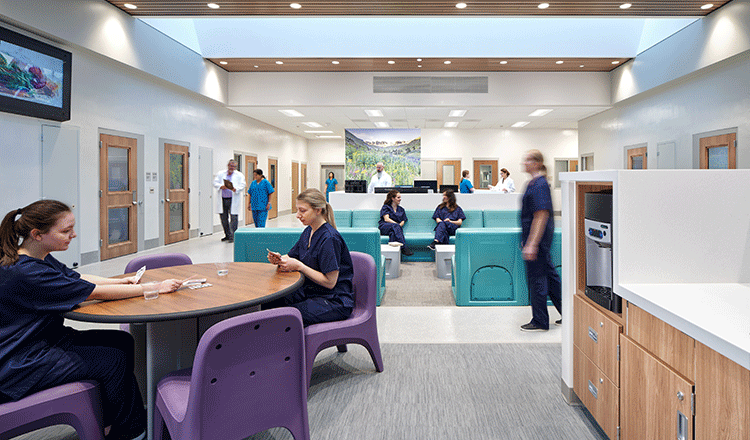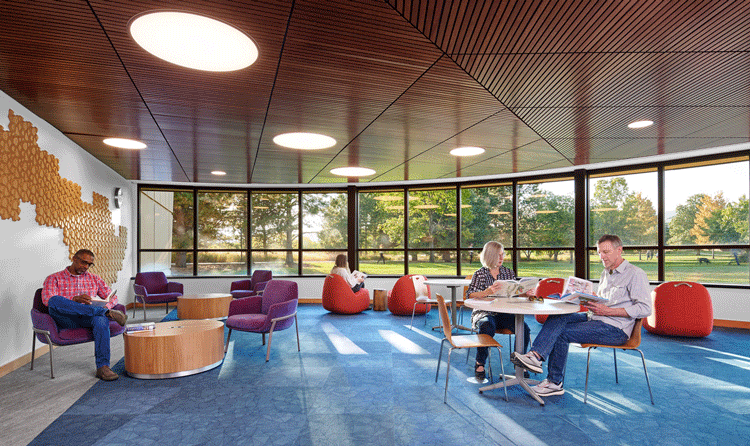
Well-Being and the Positive Influence of Biophilic Design
biophilic
bī-ō-ˈfi-lik
ADJECTIVE
of, relating to, or characterised by biophilia: relating to, showing or being the human tendency to interact or be closely associated with other forms of life in nature.
The ethereal colour of the sky at dawn or dusk. The relaxing sound of waves rolling up on the beach. The purifying scent of the pine forest in the mountains. The comfortable feeling of warm sunlight and a gentle cool breeze across the skin.
The sensory experience of nature takes many forms and has a profound impact on human behaviour. Through sight, sound, scent and touch, our personal connection with our surroundings shapes who we are, how we think and how we act. By intentionally integrating biophilic design into the built environment, we can nourish our innate desire to connect with nature and natural systems. Considering cognitive, physical and psychological responses, we can shape spaces that promote restoration, energise overall well-being and ground us with a sense of place.
Being Intentional About Biophilic Design
By identifying opportunities to engage biophilic design principles, designers can harness the sensory experience of nature in both interior and exterior spaces to elicit positive emotional responses and stimulate cognitive ability.
Providing access to natural light and views of nature are core ways to achieve positive effects of biophilic design. Prioritising visual connections to nature—alongside thermal and airflow variability—can deliver learning and healing environments that boost cognitive engagement and reinvigorate the body. Keeping end users’ health and well-being in mind during programming and planning, designers must understand how light and air will move through a space and use indoor-outdoor program adjacencies, intentional view corridors and vantage points to maximise its benefits.
Daylight and Views to Nature
Designers can use daylight and views to set the stage for a wide spectrum of interaction early in the design process. Intentional applications of light can have a profound impact on communal spaces where people interact casually or socially. The interplay between light, shadow, reflectivity and the effects of dappled light form patterns that change over time, creating visual interest and connecting users to the natural circadian rhythms of all living things. An important consideration in environments which have specific requirements for controlled lighting and or privacy, including research labs, acute care spaces and spaces requiring high security or protection, equitable access to natural daylight can be achieved through thoughtfully placed windows and openings, the integration of skylights and clerestories or replicating lighting effects through technology and lighting systems controls.
An example of this can be found at the Illinois Department of Corrections Inpatient Treatment Center in Joliet, where skylights bring natural daylight to the centre of the facility and deliver a sense of the natural environment to highly secure interior spaces. To validate this approach, the team used daylight and acoustical analysis to confirm the impacts of these patient spaces met client expectations relating to stress reduction, health and overall wellness.

Materials, Colour and Texture
Colour, geometric patterns and textures found throughout nature are vibrant, complex and tactile. These features influence mood and emotion, create a sense of awe and reduce boredom. Interior finishes mimic natural materials and colours found in nature and encourage feelings of warmth and familiarity through connections to the natural world. Integration of wood and wood grain patterns, plant and leaf forms, masonry and fractal patterns also reinforce this connection.
The Belmar Library in Lakewood, Colorado, embodies these ideas through many intentional design decisions, such as incorporating a rich wood ceiling arranged in a leaf-like pattern to draw the users’ eyes outward to the surrounding trees and open spaces.

Non-Visual Sensory Connectivity
While views of natural landscape forms, plants and trees provide direct connections to nature and promote positive impacts to our well-being, non-visual strategies for sensory engagement are also key within biophilic design. The presence of water can contribute to stress reduction and auditory comfort. An open window or variability in a controlled airflow system can provide sensory stimulation and improve mental alertness. Unique elements can invoke reactive experiences, such as a sense of awe or thrill of discovery. These “moments of awe” have proven positive benefits on mental health and overall well-being. Similarly, comfort and calm can be found through the sense of protection and refuge within one’s surroundings.
Connecting people physically and emotionally by emphasising a distinct sense of place can also set the stage for sensory engagement. The Delbrook Community Centre in North Vancouver, Canada, is deeply intertwined with its surrounding environment, with an open layout that maximises views out to the landscape from the many activity spaces within. This community anchor focuses on fitness, creativity and overall mind and body wellness, which is reinforced by this deliberate connectivity to its surroundings.
As humans, a nurtured connection with nature is integral to improving our overall well-being. When biophilic strategies come together by design, the built environment collaborates with nature, rather than against it, to engage our senses and ground us in the natural world. With time, and as designers continue to elevate natural elements in their work, we will see that this connectivity of ourselves and our buildings to nature will evolve our view toward the built environment and highlight the positive contributions buildings can also make to our overall well-being.
